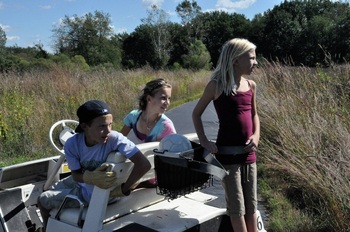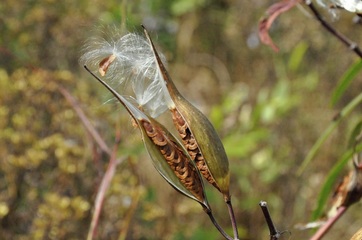|
First Frost
Steals in your absence Leaving fingerprints glistening in first light. Each touched—leaf, late bloom, final fruit-- frosty lips leaving goodbye kisses. You begged-- Cover, save, don’t let this end. Blooms could ripen once more Yield one more fruit, One more good work. I wrestle tarps and sheets in biting wind A job for two, but you have left me with only instructions Impossible to follow, alone. Tonight’s showy star-filled sky offers no shield To temperature’s plunge. Let them go—balmy air cannot revive their limp reminders of beauty-- Shriveled orange nasturtiums, red peppers, zucchini, Raspberries, drooping on their cones. Dust to dust; plow death under, fuel another spring’s abundance. Frost, come Have your way While I burrow under quilts Praying for life’s swift return. C. Rottman, 10/12/09 This poem was written a year ago but more or less summarizes the previous ten autumns. First frosts conveniently occur during the times of my husband’s annual fall outing. He is never ready to say good-bye to his wonderful summer avocation or to warm weather for that matter. He plants late beans to see if he can extend the season, he says. So we cover, uncover and hope for a few more warm days. Or, I should say I cover. This year was different. First frost came before he left so we could together drape all the plants with tarps, sheets and plastic packing material. Second frost came the next night but although he had gone the covers were still in place. I got a friend to help me lift them off and fold before almost two weeks of gloriously balmy weather. Third frost found him home but we missed all talk of freeze warnings until after 11pm. We dutifully found what light we could and covered again. Those beans got another chance at life! But as we removed the covers we agreed: time to put the garden to bed. We went so far as to stow all the covers in the barn. One balmy afternoon, I picked all the good-sized green tomatoes and trimming back the thick vines so Fritz could find the tomatoes cages, while he cleaned up the empty beds. We were dog-tired when Fourth Frost again caught us unawares on the eleven o’clock news; I shouted, “No, I’m not doing that again...” I check the Weather Bug and convince him 37 would be the low in our area. You can guess the scene in the morning—a tinge of white on the grass and the lower garden. Frost brought its deadly kisses to the zucchini, green beans and one volunteer tomato plant that was still producing great Roma tomatoes. Both of us felt disappointment, second thoughts about giving in to the warm bed—but were rational enough to know that all good gardens must come to an end. We can’t take any credit for the perfect summer, as witnessed on the prairie with wildflowers and grasses, or the abundant garden yield or now a perfectly unfolding autumn. Just the right balance of sun, and moisture made all growing things thrive. Including the two of us. So this late afternoon we did put that old garden to bed. As Fritz pulled his dozen tomato “trees” up with their cages, I picked up hundreds of fallen tomatoes. It was cold but the breeze was kind. At dusk, as we finally called it a day and headed in for a bowl of vegetable soup, the near full moon rising over the lake got our attention. Shalom. We were thankful to be entrusted as stewards of this piece of ground by the One who always gives the increase—ever so generously in the summer of 2010.  Eleven years ago we bought an old golf cart from a golf course who also bought it used and drove it into the ground. By our estimation the vehicle is now 25 years old. It is nothing fancy: its threadbare tires give zero traction; it has no canopy protection from the sun and can only seat three small people. But, it is a workhorse. My husband drives it on short hops from the house to the barn and back usually loaded with tools and implements. It is perfect for bringing the very young and the very old around the land and into the woods. A little plastic trailer hitches to the back for hauling all manner of debris from one place to another. It has one more important function, which all the grandchildren know: it offers the first driving experience for those approaching the time when we must trust them in cars on the open road. This year cousins Matt and Chris turned 16 and no doubt recalled their first solo drives as they took to the real streets behind real steering wheels. The paths through our fields are a perfect place to learn in a cart that cannot exceed 3 miles an hour. So on a recent Sunday afternoon our 13-year-old twins, Brian and Marielle, were invited to drive the cart with their younger sister, Morgan—unaccompanied. We could hear their squeals across the open land but trusted their safety. They were still laughing when they returned—telling tales about the other’s lack of driving know-how. They even let 9-year-old Morgan have a turn. No wonder I saw “off-road” tracks beside the driveway the next day! Fortunately they have a few more years of golf cart practice to perfect their skills. When the River City Wild Ones (www.rivercitywildones.org) asked to come for a prairie tour in September, I hesitated. The fields of wildflowers had already shed their blooms as the tall grasses began to tower over them. Early morning sights are best, with sun over the dew-covered plants, all going to seed. As far as mid-day, eye-catching beauty is concerned—there was not much. In the same way as I had done in early spring (See "Only a Snapshot, 7/5/10) I hoped that visitors could see the land I love—dressed in its Sunday best. We set the date but several times before the appointed time, I resisted my husband’s pleas to “call this off; there is nothing to see.”
The tour evening came with more unpredictability: the sky overcast, gusty winds pushing the tall stalks back and forth, and light rain. I doubted anyone would come. I should not have doubted the Wild Ones! Almost 30 strong arrive right on time eager to explore. They brought a little roving microphone, which allowed everyone to hear whatever we could add to their observations. They brought abundant knowledge of native plants and enthusiasm for the wild things at Flat Iron Lake. We were blessed by their presence. The evening concluded with eats on the deck overlooking the lake, while folks meandered back from the beehives, the vegetable garden and the fields. We should not have worried about presentation. Part of nature lore is the natural progression from birth to death of all growing things. It is easy to identify wildflowers by their blooms, but much harder from new, budding growth or from drying stalks. I began All Nature Sings in November—the hardest month to be stirred by thoughts of love. But seeing the cycle of months and seasons is vital to getting the whole story—not just the most exciting part. As I walk down the drive today, watching the milkweed pods burst with silver seeds and seeing the bronze glow on the Indian grass, an old song runs through my mind: “Darling, I am growing old—silver threads among the gold…” True lovers know that old age has a purposeful loveliness all its own. |
Join Carol's Mailing List
Categories
All
Archives
April 2016
|



 RSS Feed
RSS Feed
